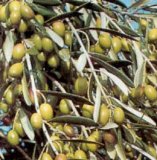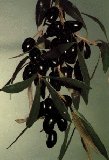Olive
http://www.100md.com
《e Natural Health Center》
 |
 |
 |
Fruits
Olive
Latin:
Olea europaea
Origin:
The edible fruit of a subtropical, broad-leaved, evergreen tree Olea europaea L., belonging to the Oleaceae family. The tree's beauty has been extolled for thousands of years. In Greek mythology, Athens is named for the Goddess Athena who brought the olive to the Greeks as a gift. Zeus had promised to give Attica to the god or goddess who made the most useful invention. Athena's gift of the olive, useful for light, heat, food, medicine and perfume was picked as a more peaceful invention than Poseidon's horse--touted as a rapid and powerful instrument of war. Athena planted the original olive tree on a rocky hill which we know today as the Acropolis. The olive tree which grows there today is said to have come from the roots of the original tree.
, http://www.100md.com
The olive was a native to Asia Minor and spread from Iran, Syria and Palestine to the rest of the Mediterranean basin 5,000 years ago. It is among the oldest known cultivated trees in the world--being grown before the written language was invented. It was being grown on Crete by 3,000 BC and may have been the source of the wealth of the Minoan kingdom. The Phoenicians spread the olive to the Mediterranean shores of Africa and Southern Europe. The olive culture was spread to the early Greeks and Romans. As the Romans extended their domain they brought the olive with them. Olive oil was prized for anointing the body in Greece during the time of Homer. The Romans developed a screw press, described by Pliny, for the production of olive oil. The Egyptians used olive oil as a lubricant in moving heavy building materials. In the past several hundred years the olive has spread to North and South America, Japan, New Zealand and Australia.
, 百拇医药
In the late 20th century, Spain and Italy were the world leaders in commercial olive production, with more than a quarter each of the world's total followed by Greece, with more than a 10th. Other important olive-producing countries are Turkey, Tunisia, Morocco, Syria, and Portugal. Europe, with nearly 500 million olive trees, has more than three-quarters of the world's cultivated olives, followed by Asia (about 13 percent).
The tree, ranging in height from 3 to 12 metres or more, has numerous branches. Its leaves, leathery and lance-shaped, are dark green above and silvery on the underside and are paired opposite each other on the twig. The wood is resistant to decay. If the top dies back, a new trunk will often arise from the roots.
, 百拇医药
Olive trees bloom in late spring. Small, whitish flowers are borne in loose clusters in the axils of the leaves. Flowers are of two types: perfect, containing both male and female parts, which are capable of developing into the olive fruits; and male, which contain only the pollen-producing parts. The olive is wind-pollinated. Fruit setting in the olive is often erratic; in some areas, especially where irrigation and fertilization are not practiced, bearing in alternate years is the rule. The trees may set a heavy crop one year and not even bloom the next.
, 百拇医药
The olive fruit is classed botanically as a drupe, similar to the peach or plum. Within the stone are one or two seeds. Olives tend to have maximum oil content (about 20━30 percent of fresh weight) and greatest weight six to eight months after the blossoms appear. At that stage they are black and will continue to cling to the tree for several weeks.
Fruits for oil extraction are allowed to mature but, for processing as food, immature fruits are picked or shaken off the tree. Hundreds of named varieties of both types of olives, table and oil, are grown in warm climates. In California, olives such as the Mission variety are grown almost exclusively for table use. In Europe, olives such as the Picual, Nevadillo, and Morcal are grown mostly for oil.
, 百拇医药
Commercial olive production generally occurs in two belts around the world, between 30° and 45° N latitude and between 30° and 45° S, where the climatic requirements for growth and fruitfulness can be found. Olive varieties do not come true from seed. Seedlings generally produce inferior fruit and must be budded or grafted to one of the named varieties.
Olives can be propagated by cuttings, either by hardwood cuttings set in the nursery row in the spring or by small, leafy cuttings rooted under mist sprays in a propagating frame. The trees start bearing in 4 to 8 years, but full production is not reached for 15 or 20 years.
, 百拇医药
Olives are grown mainly for the production of olive oil. The fruit is up to 4 cm long. Fresh, unprocessed olives are inedible because of their extreme bitterness resulting from a glucoside that can be neutralized by treatments with a dilute alkali such as lye. Salt applications also dispel some of the bitterness. The processed fruit may be eaten either ripe or green. The olive fruit and its oil are key elements in the cuisine of the Mediterranean and popular outside the region.
, 百拇医药
Olive oil is classified into five grades: (1) virgin, from first pressings that meet defined standards; (2) pure, or edible, a mixture of refined and virgin; (3) refined, or commercial, consisting of lampante from which acid, color, and odor have been removed; (4) lampante, high-acid oil, named for its use as a lamp fuel, obtained from a second pressing of residual pulp with hot water (some inferior virgin oils are classed as lampante); (5) sulfide, extracted with solvents and refined repeatedly.
, 百拇医药
Properties:
Sweet and sour in flavor, cool in nature, it is related to the lung and stomach channels.
Functions:
Olive nourishes body fluids and quenches thirst, clears lungs and eliminates sputum, detoxifies and is good for sore throat.
Applications:
1. For sore throat:
, 百拇医药
Keep a fresh or preserved olive in the mouth and swallow the saliva bit by bit. For preserving the olive, just add salt to the olives after drying in the shadow for 1-2 days. Store the olives in an earthenware vessel. After a period of 2 weeks, preserved olives are ready for use. The stones inside the olive may be removed or preserved intact.
2. For alcoholism:
Pound 5-10 fresh olives. Use 200 ml water, add 40 g sugar and boil for 15 minutes. Consume the solution. Repeat when necessary.
, 百拇医药
3. For chronic coughing:
Use 5 fresh olives and mix with rock sugar in appropriate amount. Steam for half an hour and eat them.
Dosage and Administration:
Olive fruits are widely used, especially in the Mediterranean, as a relish and flavoring for foods. The fruit is usually pickled or cured with water, brine, oil, salt or lye. They can also be dried in the sun and eaten without curing when they are called "fachouilles."
, 百拇医药
The cured fruits are eaten as a relish, stuffed with pimentos or almonds, or used in breads, soups, salads, etc. "Olives schiacciate" are olives picked green, crushed, cured in oil and used as a salad.
The seed is rich in an edible non-drying oil, this is used in salads and cooking and, because of its distinct flavor, is considered a condiment.
Cautions on Use:
Reference Materials:
, 百拇医药
Toxic or Side Effects:
Modern Researches:
Olive contains protein, fat, sugar, vitamins C and D, calcium, phosphorus, iron, volatile oil and amyrin.
The oil from the pericarp is cholagogue (promotes the flow of bile into the intestine), a nourishing demulcent, emollient and laxative. Eating the oil reduces gastric secretions and is therefore of benefit to patients suffering from hyperacidity. The oil is also used internally as a laxative and to treat peptic ulcers. It is used externally to treat pruritis (itching), the effects of stings or burns and as a vehicle for liniments.
, 百拇医药
Used with alcohol olive oil is a good hair tonic and used with oil of rosemary it is a good treatment for dandruff. The oil is also commonly used as a base for liniments and ointments.
The non-drying oil obtained from the seed is also used for soap making, lighting and as a lubricant. The oil is a good hair tonic and dandruff treatment.
The leaves are antiseptic, astringent, febrifuge and sedative. A decoction is used in treating obstinate fevers, they also have a tranquilizing effect on nervous tension and hypertension. Experimentally, they have been shown to decrease blood sugar levels by 17-23 percent. Externally, they are applied to abrasions.
, 百拇医药
The bark is astringent, bitter and febrifuge (removes fever). It is said to be a substitute for quinine in the treatment of malaria.
In warm countries the bark exudes a gum-like substance that has been used as a vulnerary.
It was reported in 'Eating Your Way to Health' that olive was effective for acute bacillary dysentery (disorders marked by inflammation of the intestines) and skin diseases. For dysentery, put 100 g olive with the kernel in an earthenware pot and add 200 ml water. Cook with slow fire for 2-3 hours until half volume of water is evaporated. Use the solution 3-4 times daily until normal stool appears. Forty-nine cases were cured clinically with fever subsiding 12 hours after administration. For eczema, acute dematitis with exudates, pound the stoned olive and apply it locally. These results were also satisfactory.
, http://www.100md.com
Maroon and purple dyes are obtained from the whole fresh ripe fruits.
Blue and black dyes are obtained from the skins of fresh ripe fruits.
A yellow/green dye is obtained from the leaves.
Plants are used to stabilize dry dusty hillsides.
Wood of the olive tree is very hard, heavy, beautifully grained, takes a fine polish and is slightly fragrant. It is used in turnery and cabinet making, being much valued by woodworkers., 百拇医药